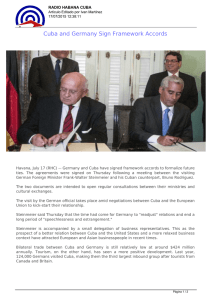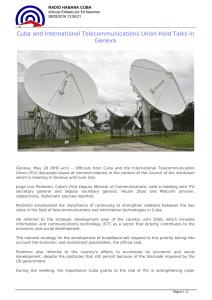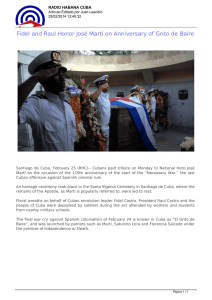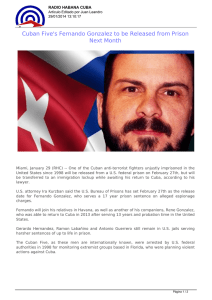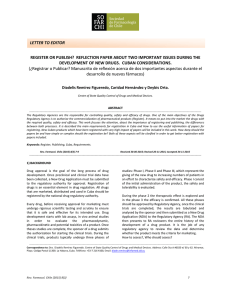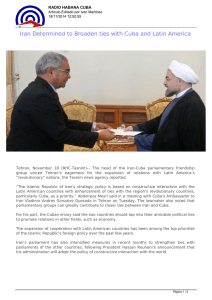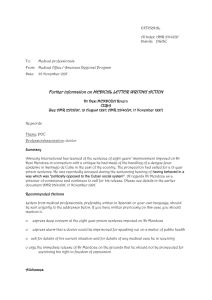The Indians of Cuba: A Study of Cultural Adaptation and Ethnic
Anuncio
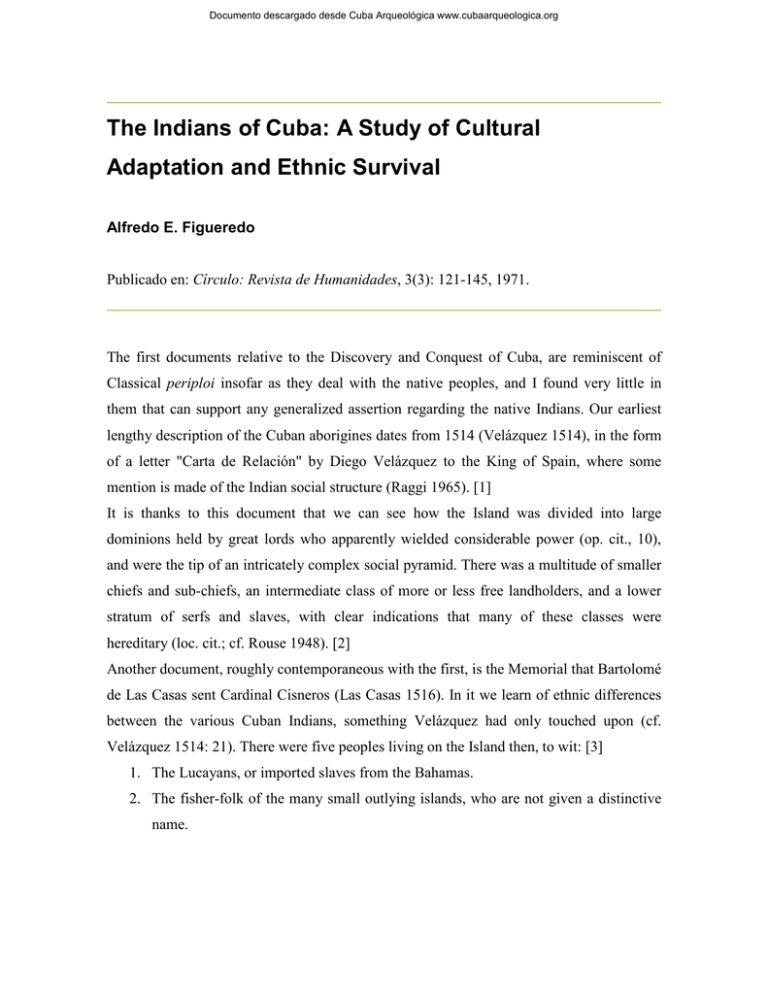
Documento descargado desde Cuba Arqueológica www.cubaarqueologica.org The Indians of Cuba: A Study of Cultural Adaptation and Ethnic Survival Alfredo E. Figueredo Publicado en: Círculo: Revista de Humanidades, 3(3): 121-145, 1971. The first documents relative to the Discovery and Conquest of Cuba, are reminiscent of Classical periploi insofar as they deal with the native peoples, and I found very little in them that can support any generalized assertion regarding the native Indians. Our earliest lengthy description of the Cuban aborigines dates from 1514 (Velázquez 1514), in the form of a letter "Carta de Relación" by Diego Velázquez to the King of Spain, where some mention is made of the Indian social structure (Raggi 1965). [1] It is thanks to this document that we can see how the Island was divided into large dominions held by great lords who apparently wielded considerable power (op. cit., 10), and were the tip of an intricately complex social pyramid. There was a multitude of smaller chiefs and sub-chiefs, an intermediate class of more or less free landholders, and a lower stratum of serfs and slaves, with clear indications that many of these classes were hereditary (loc. cit.; cf. Rouse 1948). [2] Another document, roughly contemporaneous with the first, is the Memorial that Bartolomé de Las Casas sent Cardinal Cisneros (Las Casas 1516). In it we learn of ethnic differences between the various Cuban Indians, something Velázquez had only touched upon (cf. Velázquez 1514: 21). There were five peoples living on the Island then, to wit: [3] 1. The Lucayans, or imported slaves from the Bahamas. 2. The fisher-folk of the many small outlying islands, who are not given a distinctive name. Documento descargado desde Cuba Arqueológica www.cubaarqueologica.org 3. The Guanahacabeyes, which Velázquez had called Guanatabeyes (loc. cit.), and were a rude, non-agricultural group living in the western extremity of the Island (ibidem; Las Casas 1516: 8). 4. The Cibuneyes (or Ciboneyes), similar to the fisher-folk, yet somehow distinct, and largely held in bondage by the last group, 5. which were the more advanced and dominant group, again unnamed, but of whom Las Casas wrote elsewhere as being in some cases recent immigrants from Hispaniola (Las Casas 1559: II, 507). [4] In recent times archaeologists have referred to these last as the Taíno Culture, a term popularized mainly by the Swedish anthropologist Sven Lovén during the twenties and thirties (Lovén 1924), and which is a derivation from the adjective meaning 'good' in the Xaraguá language of Hispaniola (cf. Martyr 1516: I, 123). [5] The available evidence indeed confirms a Hispaniolan origin for the more advanced cultural complexes (Harrington 1921: II, 425), and non-agricultural peoples of aceramic material cultures have been found to have lived contemporaneously with and near to these higher cultures (Utset 1951: 101). [6] Linguistically, the more advanced groups have been related to the Lokono or True Arawak language of Guyana (Brinton 1871), though lately there is some doubt as to this connection (Taylor 1960), the more venturesome linguists suggesting only a very early split between the Arawak languages of the Mainland and Taíno, as the insular variety is known (Noble 1965). At any rate, there is no doubt that Taíno, or at least its Xaraguá form, was the general speech of Hispaniola and parts of Cuba when the Spaniards arrived (cf. Las Casas 1556: II, 311). [7] About the social structure of the Taíno, we can say that among them the commoners were obviously numerically preponderant, and these included at least three distinct classes (Raggi 1965: 10). At the very bottom appear to have been a class referred to as tamemes (op. cit., 27-28; Velázquez 1514: 13), or laborers wholly at the disposition of the local rulers, who could be sent to work wherever their lord wished them to go, and may have been chiefly porters (ibidem). Next and of greater importance not only socially but economically as well, were the naborías, who were servants bound to the soil (cf. La Torre 1530), though they could also be used for domestic duties in households (Raggi op. cit.: 10, Documento descargado desde Cuba Arqueológica www.cubaarqueologica.org 27), and these may have formed the bulk of the population, because I find that most early documents dealing with the distribution of Indian serfs among Spanish conquistadores, speak only of naborías (cf. Fernández-Duro 1888); also, perhaps both name and role were not ethnic in character, and most naborías were ciboneyes as well, a fact that could account for Las Casas' statement that most of the Cubans styled themselves ciboneyes (Las Casas 1559: II, 507). [8] There was a class of free landholders without exceptional status other than their relative individual independence (Raggi 1965: 10), and these were called guaoxerís, which meant a deferential address much as the Renaissance Spanish term vuestra merced as applied to a knight (ibidem; Las Casas 1556: II, 309), and the name apparently gave rise to the modern Cuban expression guajiro, which refers to a native-born white farmer (cf. Montori 1916: 91). [9] All nobles but the behiques held territorial rights (cf. Raggi op. cit.: 27), and then these I consider noble because of their exalted position and some evidence for the post being hereditary; behiques were medicine-men or shamans, who attended the cemís or household gods, and prayed to the Creator, Yócahu Vagua Maórocoti, for certain visions (cf. Rivero de la Calle 1966: 139; Arrom 1971: 184-185; Las Casas 1559: II, 514-515). The Cuban behiques apparently attended to visions chiefly, whereas their Hispaniolan counterparts were more active in medicinal endeavors (loc. cit.). [10] The nobles ruling small numbers of naborías and their pertaining land were usually called nitaínos (Rivero de la Calle 1966: 138; Las Casas 1559: I, 398), meaning something like the Mediaeval French bons hommes, since taíno at any rate originally meant 'good' (Martyr 1516: I, 123). Above these were the petty lords of villages or provinces, called baharís in Hispaniola (Las Casas 1556: II, 309), but whose name in Cuba we ignore, since the sources prefer the term cacique, which means 'lord over a land'; one author, at least, thinks this Hispaniolan usage extended to Cuba as well (Raggi 1965: 27). The most powerful of all the caciques were called matunherís, perhaps 'noble ones', since matum meant 'noble' (Raggi op. cit.: 7; Martyr 1516: I, 361). These could exact tribute from other lords, and themselves be suzerains over other matunherís (cf. Raggi op. cit.: 34-37). Since descent was recorded matrilineally, and the husband resided in his wife's household in cases of political marriages "though such appears not to have been a set rule" (cf. Oviedo 1535: I, 118-124), Documento descargado desde Cuba Arqueológica www.cubaarqueologica.org occasionally a ruler came from a region other than the one he ruled, and in Hispaniola a woman was once cacique of Xaraguá (Las Casas 1556: II, 308). [11] We have already seen how primitive peoples whom we may very well by comparison call barbarians lived side by side with the Taíno. Some evidence points to their having been clients of the more powerful agriculturalists (Pichardo Moya 1945b: 81), and indeed since no record is extant for a single guanatabey chieftaincy or political area (cf. Velázquez 1514), we may so believe for the present at least. [12] The artifacts which we know were in general everyday use among the more advanced groups come mainly from the archaeological record, and include the usual Neolithic tool kit: pottery (platters, dishes, bowls, cooking pots, water jars); clay instruments such as whistles, spindle whorls and rings; polished stone celts; flint knives, scrapers, perforators, and points; shell gouges, cups, dishes, and ornaments; bone awls, needles, spatulas, beads, and pendants, as well as a largely lost assemblage of wooden objects, basketry and textiles (Tabío and Rey 1966: 203-206; cf. Harrington 1921). [13] Some ritual artifacts have been found such as bone swallow-sticks carefully decorated and used to induce vomiting (Rivero de la Calle 1966: 151), and Las Casas wrote of cottonwoven objects placed around an altar (Las Casas 1559: II, 534). There are also several ceremonial seats extant, carefully carved from wood and inlaid with precious stones and gold (Rivero de la Calle op. cit.: 139, 148-149). [14] One of the most outstanding traits of Taíno Culture was the worship of cemís or household gods along the lines of the Roman lares and penates (Las Casas 1559: II, 514). These were represented by small fetishes carved of shell, bone, wood, or stone, and are found profusely in most sites. Clay dolls, apparently fertility deities, are also present (Tabío and Rey 1966: 204). [15] Large villages sometimes had elaborate courts surrounded by gigantic earthen embankments, of which Monte Cristo is a typical example (Harrington 1921: I, 209), and these sometimes had inscribed stone slabs reminiscent of menhirs inside them. Other earthen monuments are known, some really puzzling in shape, whereas at least one is recorded and carefully mapped as having the outline of a bat when viewed from the air (Rivero de la Calle and Núñez Jiménez 1958: 50), which animal may have had some Documento descargado desde Cuba Arqueológica www.cubaarqueologica.org religious significance since it is found all over art objects such as the fancier ceramic vessels which are thought to be ceremonial (op. cit., 55; cf. Herrera Fritot 1952). [16] Agriculture was practiced extensively and included such staples as both sweet and bitter manioc (Manihot spp.), Indian corn or maize (Zea mays), sweet potatoes (Ipomœa batatas), beans (Phaseolus spp.), and several varieties of additional root crops of a more arcane nature (Calathea allouya, Xanthosoma sagittæfolium, etc.). There is evidence for the cultivation of peanuts (Arachis hypogæa) (Rivero de la Calle 1966: 26), and a kind of pepper, Capsicum frutescens, was widely cultivated (Pérez de la Riva 1951). It appears that bitter manioc, in its preservable pancake or cassava form, supplied the staple food, a case similar to that in northern South America, and which adds strength to the theory that Taíno Culture may have found inspiration in, if not derived from, the Venezuela-Guyanas area (Cruxent and Rouse 1958: I, 264-265). [17] The Conquest of Cuba really began in 1509, when a shipwrecked group of Spaniards won the friendship and respect of the Indians in the chieftaincies of Cueybá and Macaca (also spelled Coyva and Mahaha in contemporary sources), even converting all of the former area's people to the worship of a Fleming image of the Virgin Mary (Las Casas 1559: II, 403-404, 513-514). It is not until Diego Velázquez sets out from the Spanish settlement of Salvatierra de la Çabana in Hispaniola with 300 men and the full backing of the Second Admiral at Santo Domingo, that an effective occupation begins; this was around new year's eve, 1511 (Las Casas op. cit.: II, 522). [18] The Indians' puny weapons, such as bows and arrows, were no match to Spanish swords, crossbows, and cuirasses (Las Casas op. cit., loc. cit.); few caciques offered any resistance, most of the population actually welcoming the Spaniards and showing themselves quite willing to learn new ways (Raggi 1965: 44). The number of Indian deaths resulting from combat between 1511 and 1516 has been put at between 15 and 20 by an eyewitness that was very liberal with numbers (Las Casas 1516: 8). Indeed, Velázquez encountered very little opposition and then mainly from recent fugitives that, fleeing Spanish colonial rule in Hispaniola, had established themselves in eastern Cuba (Las Casas 1559: 523). The conquistadores were quick to establish the encomienda system enforced on the conquered islands, whereby Spanish settlers were assigned different numbers of caciques and/or naborías to rule over as feudal lords and instruct them in the Christian Faith. Encomiendas Documento descargado desde Cuba Arqueológica www.cubaarqueologica.org worked because they fitted nicely into the old Indian social structure, and it was easy for the natives to accept a matunherí who was a stranger to them; to facilitate the transition, many Spaniards married the daughters of caciques in order to inherit or replace them as rulers of their domains (Raggi 1965: 10-11). [19] The encomienda system was abolished as most Indians acculturated and could no longer be held in bondage over the objections of the Kings of Spain, who always did their best to protect the Indians from their many unscrupulous white subjects (cf. Despinosa 1553: 356357; Rojas 1533: 324). By the second half of the 16th century, most of the Indians had doubtless become Spaniards by all counts save race, and there never was a racial line separating whites from Indians (cf. Raggi op. cit., loc. cit.), as there was between white and Negro, so that intermarriage seems to have been frequent. [20] The Spanish Colonization was so thorough that by 1514 there were seven fully instituted cities; true, they were puny by modern standards, but still influenced very deeply the character of modern Cuban urban culture, which remained nearly all-Spanish in character. Contrasting with this, the Indian element seems to have blended with and influenced the Spanish settlers in the countryside, who had to learn new subsistence techniques in their new country (García Castañeda 1949). The crops grown and the technical terms used by the Spanish farmers made them indistinguishable from their Indian neighbors, whereas in dress used, language spoken daily, and general customs, much the same can be said for the majority of the Indians with respect to the Spaniards (op. cit.; Culin 1902: 191). [21] It is in one of the first and most complete lists of encomiendas granted, detailed by Spanish civil jurisdiction and caciques and naborías involved, that we find the earliest clear evidence of Indian towns kept as such and granted in toto to individual Spaniards (La Torre 1530). Another document mentions the town of Yara, known as an Indian settlement to this day (Burgos 1546: 290). With the granting of freedom to the Indians, some of these towns and their adjacent lands were made into reservations for the protection of the Indians, inside whose area no white man could live (Culin 1902). [22] In western Cuba, the area most densely settled by Spaniards and still the demographic center of the Island (Marrero 1957), we only have information for two Indian settlements persisting alongside Spanish ones and retaining an Indian flavor. These are Guanabacoa, and the town of the Macurixes. Guanabacoa was soon turned into a Spanish town by the Documento descargado desde Cuba Arqueológica www.cubaarqueologica.org influx of white settlers from nearby Havana (Roig 1937: 49), while the Macurixes were runaways from Hispaniola, and subsisted more or less independently in the wilderness until they were subdued in the early XVII Century (Escoto 1924). [23] In eastern Cuba the situation was far different, and Indian towns such as Yara we have seen, persisted until our times. There have been considerable migrations of Indians from one area to another (cf. Culin 1902: 199), and the modern Cuban city of Jiguaní, now indistinguishable from other urban centers in the Island, was founded as an Indian town by Indians in the early 1700's, and as late as 1777 was recognized as such (Pichardo 1957: 75). In recent years, there have been other recorded migrations caused by the economic expulsion of the Indians away from good lands to more remote areas, victimized by the industrial expansion of their white neighbors who kept encroaching upon their lands and establishing plantations run with slave labor (Oramas 1969: 5). [24] From the above one would suppose that the Indian was persecuted and oppressed, yet such is not the case. As of 1553 we saw that practically all Indians in Cuba were free, and what they suffered at the hands of the slavocrats could not have been worse than what was the lot of the independent white farmers. Displacement from that date on seems to have been based upon the inability of free labor to compete with slave labor, a situation that was reversed in Cuba after approximately 1850, and which led to the abolition of slavery (Moreno Fraginals 1968: 44-45). [25] Again, one would believe that western Cuba, having no specifically Indian towns, was devoid of an aboriginal population. In spite of this, the parochial records of Guanes, the most westerly town in Cuba, show Indians present there much after 1600, and in nearby Pinar del Río there was still a separate baptismal book for Indians in 1773 (Pichardo Moya 1945a: 30). In 1803, a party of Indians rebelled in far western Cuba, and were so many that the Spanish governor was obliged to mount an expedition against them (Pezuela 1866: IV, 217); unhappily, these were massacred, and they may have been the last cohesive western community. [26] Occasional uprisings notwithstanding, it is clear that many Indian communities aided the Spaniards effectively, and even helped the slavocrats of eastern Cuba in putting down slave revolts (Estrada 1876: 507). Indian militias played a very prominent part in the defense of such cities as Bayamo, always troubled by foes from without and within (ibidem). Indeed, Documento descargado desde Cuba Arqueológica www.cubaarqueologica.org this alliance of the white ruling class with the Indian farmers, which really harked back to the intermarriage between the ruling classes of both groups during the early Colonization, allowed many an Indian to become fully incorporated in the Spanish social body, and 'pass for white' by assuming the role of a small freeholder loyal to the King and a bulwark for the institutions of the Realm (op. cit.; Raggi 1965). [27] The Romantic Revival, and incipient aspirations of Cubans for independence, brought about a substantial concern for the Cuban Indian, yet for the most part as the autochthonous savage of the past (Henríquez Ureña 1963: I, 174), noble precursor of the rebellious Nation. In spite of Romantic poems such as the one that begins: [28] Por la encantadora orilla que riega el Cubanacay, donde lindas flores hay y el sol más hermoso brilla, donde la tierna avecilla corta el aire en blando giro, y vegeta el caguajiro a orillas de la sabana, sobre una jaca alazana iba un rústico guajiro. Perfecto tipo de aquellos habitantes primitivos, con sus ojos expresivos y con sus negros cabellos, tostados como eran ellos, este rústico guajiro la cumbre azul del Capiro contemplaba con despecho, y ahogar no pudo en su pecho un doloroso suspiro. (/ápoles Fajardo 1856) Documento descargado desde Cuba Arqueológica www.cubaarqueologica.org with obvious allusions to surviving Indians (habitantes primitivos), the urban literateurs capitalized upon a fantastic story which held that all Cuban Indians had been massacred by the Spanish conquistadores, a story which was supposed to portray the Peninsulars as cruel juxtaposed to the suffering Cubans, but which missed the mark widely since modern Cubans are of course descended from the conquistadores; not so the Spaniards then, who descended from those that had remained in Europe, and were quite innocent of what their overseas brethren may have done. Actually, the Indians were then a tiny population compared to the rapidly expanding 'white' mass, constantly fed by immigrants from Europe, and thus could be easily ignored by popular opinion as a living entity. [29] Intermarriage with Indians was so evident in some areas that by 1845 it was ruled that the lands in the former Indian town and reservation of El Caney should revert to the Crown (Pichardo 1945: 35); in 1849, this decision was modified, and those that could prove 'pure' Indian blood or the absence of 'inferior admixture' (i.e., Negro blood), were allowed to retain their lands as individuals (op. cit.). Still, after this date we hear no more of exclusive Indian lands anywhere, and white encroachment in the specific case of El Caney becomes so strong that when a mission from the Royal Academy of Sciences at Havana visits the town in 1890, it is stated without reserve that no Indians are left there (La Torre 1890: 327). [30] When Cuba's first war for independence breaks out in 1868, we find many Indians fighting on both sides. One Cuban general, Jesús Rabí, was an Indian from Jiguaní (Culin 1902: 199), and commanded a famous unit of cavalry composed mainly of other Cuban Indians from his home town. However, I find that official Cuban communiqués refer to all forces, Negroes inclusive, in equal terms, and the aboriginal contribution to the wars of independence has been thus obscured, for no record is left of the presumably numerous Indian contingent that fought in the rebellious armies. [31] After the founding of the Sociedad Antropológica de la Isla de Cuba in 1877, there was a mild rebirth of interest in the minuscule Indian population. Montané's speech at the opening of the Society, for instance, mentions the fact that Indians (of the 'raza mongólica') lived alongside the predominant white population (Montané 1877: 366). However, archaeology and the study of the larger Negro and Chinese minorities occupied most of the Society's Documento descargado desde Cuba Arqueológica www.cubaarqueologica.org time (Sociedad Antropológica 1966), and no full report was ever read before it nor published dealing with the Indian population of modern Cuba (cf. ibidem). [32] We briefly saw how the Royal Academy of Sciences, which was influenced by the Anthropological Society, sent some expeditions to eastern Cuba during the last quarter of the 19th century; these were primarily archaeological in nature, though they collected some data on the extant Indians, but very sketchy in nature. However, the idea that these in effect existed was kept alive by the physical observation of living specimens (La Torre 1890: 328 et seq.). [33] It is not until 1901 that a more or less carefully recorded expedition visits the remaining Indians in eastern Cuba (Culin 1902). From this report, which, owing to its place of publication (Philadelphia) never circulated widely in the Island, it is that we have the first considerable set of ethnographic data for a modern Cuban Indian community. Stewart Culin, who himself was the whole expedition, observed firstly that several stevedores in the port of Guantánamo had marked Indian features and were referred to as indios. Though the most specific he ever gets as far as physical traits is concerned is the following description: [34] The Indians have black hair, light-brown complexions, and pleasing, regular features. (Culin 1902: 195). Culin nonetheless does recognize them as different from the rest of the population (ibidem). [35] As far as culture is concerned, perhaps the most significant attribute he finds is the fact that many families preserve a tradition of being Indian and try never to marry outside their race (Culin op. cit.: 194). Another interesting trait he found among remote villagers was a matrilineal reckoning of ancestry (idem: 206), though the wife went to the husband's house (ibidem). [36] In the town of Yara, the men had 'serrated, pointed teeth' (op. cit.: 208), a peculiar trait which, as far as I know, is not documented archaeologically for the Cuban Indians, who had undeformed teeth when the Spaniards found them, and this filing of the teeth may be a late cultural creation, perhaps influenced by African slaves in Colonial times (cf. Ortiz 1929); at any rate, I have read no posterior testimony reporting it among a living community, and the custom, along with any reasons that may have been gathered orally for it, may have disappeared altogether. [37] Linguistically, Culin was unable to find anyone who spoke a native language (Culin op. cit.: 192, 194), and the most peculiar trait he found was that some remote individuals, Documento descargado desde Cuba Arqueológica www.cubaarqueologica.org forming a community of about a hundred families, spoke a variant of old Spanish (op. cit.: 209). Since then, not even this has been reported, though the families in question were investigated (Oramas 1969). [38] There was still living memory then of men who had been caciques (Culin op. cit.: 205), though no rigid class structure (indeed, no class structure: they were all farmers) seems to have survived in the groups surveyed. There was a community reported but not visited by Culin, where the Indians were still living under a cacique (op. cit.: 209), and this would have been the place to look for any remnants of the old social structure. Notwithstanding the need to observe beforehand, I think it is likely that the caciques we deal with here were descended from lower-class individuals who filled the role according to need, and the old distinctions between hereditary classes had disappeared. Unless some communities be still left that have such headmen or caciques, we may never know. [39] The everyday utensils used by the Indians that Culin was able to observe, were all those used by the modern white Cuban farmer, of European or recent settler origin, and thus he does not detail them carefully (Culin op. cit.: 191, 194-195, 206). Indeed, his listing of peculiar traits was compiled from ignorance, and I can testify that all are of Spanish origin, including a wooden mortar (loc. cit.). The outward cultural uniformity of both Indians and rural white Cubans has been amply dealt with elsewhere (Rivero de la Calle 1966), though one should qualify that since no Spanish Cuban ever reckons ancestry through the mother, nor does he file his teeth, these similarities are but superficial in many cases, and detailed studies of the everyday life and customs of both groups are in order. One may very well find that, in spite of transculturation, both may still be defined as distinct cultures, though this is contingent upon field work. [39] Architecturally, there was the peculiarity of round huts (Culin 1902: 195), which Culin did not think distinctive, but which we know were not used by the white Cubans nor their Negro servants (Marrero 1957), and such structures have not been recorded again since then. [40] When Montané published a brief and sketchy report on the same subject as Culin (Montané 1911), he was completely unaware of the latter's work, yet both concluded that scarcely anything was left of the Cuban Indian culture and barely any Indians at that. Their attitude I think was ethnocentric: they expected to find a romantic wild tribe of Indians, and found Documento descargado desde Cuba Arqueológica www.cubaarqueologica.org peaceful farming communities instead; their subsequent disillusionment may have further prejudiced their reports, and they may have overlooked important cultural data merely because it was not flashy and exotic. Their underestimate of Indian population is based upon Western prejudice, which expects numbers in the tens of thousands. This is significant because the breeding population of the Cuban Indians has been misconstrued so often that one gets the impression that one must hurry to see them before they die; in reality, there are several thousands of them, and they are in no danger of extinction I can foresee. [41] Here I would like to clarify an error that found its way into the Handbook of the South American Indian, when Rouse therein states that Culin recorded the Cuban Indian population at no more than 400 (Rouse 1948: 519; cf. Culin 1902: 195). Actually, in Yara alone Culin estimated the Indian population at between six and seven hundred (Culin op. cit.: 206), and we have already seen how the remote mountaineers speaking old Spanish numbered one hundred families, which even conservatively would give us twice four hundred in those two localities alone, and half a dozen other towns are mentioned. Culin records Cuban Indians as extremely fertile (op. cit.: 204), a situation that still holds (Oramas 1969), and the population must then have increased since 1901. [42] Three or four thousand persons are lost in a population of several millions, and this accounts for the obscurity of the Cuban Indian in Insular literature. Even reputed sociologists accounted the Indians gone in the early forties (cf. Azcuy 1941), and not until Ruggles Gates climbed a few hills in 1952 were they rediscovered (Oramas 1969: 5). [43] However, this new sense of discovery did not produce any one viable monograph on the ethnology of the modern Cuban Indians, with the possible exception of a manuscript I was unable to consult (Rivero de la Calle 1966: 55). Some new information, however, has become available, chiefly that in at least one village there is a folk tradition of a time when idols of stone were made, and the Sun and the Earth were worshipped (Oramas, op. cit., loc. cit.), these last two being the chief attributes of the Supreme God of the Taínos, Yócahu Vagua Maórocoti (Arrom 1971: 190), though strangely, the third attribute (Vagua), the sea, is not mentioned, and this may be due to a loss of contact with the sea. [44] Concluding, and on the basis of the scanty evidence available, it seems possible to assume that strong cultural forces have effected a peculiar case of ethnic survival. Anthropologically, the study of precisely what factors account for this should prove Documento descargado desde Cuba Arqueológica www.cubaarqueologica.org rewarding. For now we can imagine that remote locations coupled with poor transportation over mountains account for their survival, yet what about the towns as close as three miles from a populous modern port city. (Culin 1902: 204) I was able to trace the phenomenon historically for the first time, and present a diachronically structured body of evidence coupled with a bibliography. It is to be hoped that future field work will resolve the many ethnographic lacunæ now so evident. If, as it has promised, the Revolutionary Government spurs cultural anthropology in Cuba (Guas 1968: 16), or foreign scholars are allowed to work there, we can reasonably expect very substantial results. [45] BIBLIOGRAPHY Arrom, José Juan, 1971. El mundo mítico de los taínos: notas sobre el Ser Supremo. Revista Dominicana de Arqueología y Antropología, vol. I, no. 1, pp. 181-200. Azcuy, Fanny, 1941. Psicografía y supervivencias de los aborígenes de Cuba. La Habana: Publicaciones de la Revista de Educación. 101 p. Brinton, Daniel Garrison, 1871. The Arawack language of Guiana in its linguistic and ethnological relations. Transactions of the American Philosophic Society, vol. XIV, pp. 427-444. Philadelphia. Burgos, García de, 1546. Carta de García de Burgos, Procurador de Bayamo, al Obispo, con noticias de la isla. Colección de Documentos Inéditos, de la Isla de Cuba, vol. III, p. 290. Madrid, 1891. Cruxent, J.M., and B.I. Rouse, 1958. An archaeological chronology of Venezuela. Washington: Pan American Union. 2 vols. Culin, Stewart, 1902. The Indians of Cuba. Bulletin of the Free Museum of Science and Art of the University of Pennsylvania, vol. III, no. 4, pp. 185-226. Despinosa, Diego, 1553. Testimonio del bando publicado en las villas de la isla Fernandina ordenando la libertad de los indios que se tenían por esclavos. Colección de Documentos Inéditos, de la Isla de Cuba, vol. III, p. 356-357. Madrid, 1891. Escoto, José Augusto, 1924. Los indios macurijes en Haití y en Cuba. Matanzas: no publisher. Documento descargado desde Cuba Arqueológica www.cubaarqueologica.org Estrada, Manuel José de, 1876. Bayamo. Rafael Cowley, ed., Los tres primeros historiadores de la Isla de Cuba, vol. II, pp. 501-530. Habana: Imprenta de Andrés Pego. Fernández-Duro, Cesáreo (ed.), 1888. Colección de Documentos Inéditos, de la Isla de Cuba, vol. II, xii, 476 p. Madrid. García Castañeda, José Agustín, 1949. La transculturación indo-española en Holguín. Revista de Arqueología y Etnología, no. 8-9, pp. 195-205. Havana. Guas, Aida, 1968. La Antropología. Academia de Ciencias de Cuba, Serie Cien Años de Lucha, Cien Años de Ciencia, no. 4, Havana: Cuba. Harrington, Mark Raymond, 1921. Cuba Before Columbus. Indian Notes and Monographs of the Museum of the American Indian (Heye Foundation), Miscellaneous no. 17. 2 vols. New York. Henríquez-Ureña, Max, 1963. Panorama histórico de la literatura cubana. Puerto Rico: Ediciones Mirador. 2 vols. Herrera Fritot, René, 1952. Arquetipos zoomorfos en Las Antillas Mayores. Revista de Arqueología y Etnología, no. 15-16, pp. 215-226. Havana. Las Casas, Bartolomé de ---------. 1516 Memorial sobre remedio de Indias presentado al Cardenal Cisneros por Fr. Bartolomé de Las Casas, and: Nuevo Memorial de los agravios y sinrazones que Bartolomé de Las Casas, clérigo, dice que se hacen á los indios. Colección de Documentos Inéditos, de la Isla de Cuba, vol. III, pp. 6-11. Madrid, 1891. ---------. 1556 Apologética Historia Sumaria. México: Universidad Nacional Autónoma, 1967. 2 vols. ---------. 1559 Historia de Indias. México: Fondo de Cultura Económica, 1951. 3 vols. La Torre, Juan de, 1530. Testimonio que da el escribano Juan de la Torre de los indios que ha repartido Gonzalo de Guzmán. Colección de Documentos Inéditos, de la Isla de Cuba, vol. II, pp. 109-128. Madrid, 1888. La Torre, Carlos de, 1890. Conferencia científica. Anales de la Real Academia de Ciencias Médicas, Físicas y /aturales de La Habana, vol. XXVII, no. 315, pp. 325-343. Lovén, Sven, 1924. Über die Wurzeln der tainischen Kultur. Göteborg: Elanders Boktrykeri Aktiebolag. ix, 453 p. Marrero, Leví, 1957. Geografía de Cuba. La Habana: Editorial Minerva. Documento descargado desde Cuba Arqueológica www.cubaarqueologica.org Martyr, Peter,1516. Décadas del /uevo Mundo. Traducidas del latín por Agustín Millares Carlo. México: Porrúa. 2 vols. Montané, Luis ---------. 1877 La Antropología en Cuba. Revista de Cuba, vol. II, pp. 363-369. Havana. ---------. 1911 Misión científica por el Dr. Luis Montané. Anales de la Real Academia de Ciencias Médicas, Físicas y /aturales de La Habana, vol. XLVII, pp. 702-736. Montori, Arturo, 1916. Modificaciones populares del idioma castellano en Cuba. Habana: Imp. de Cuba Pedagógica. 240 p. Moreno Fraginals, Manuel, 1968. Azúcar, esclavos, y revolución (1790-1868). Casa de Las Américas, no. 50, pp. 35-45. Havana. Nápoles Fajardo, Juan Cristóbal, 1856. Rumores del Hórmigo. Segunda edición. Habana: Imprenta de "El Tiempo", 1858. 280 p. Noble, G. Kingsley, 1965. Proto-Arawakan and its descendants. International Journal of American Linguistics, vol. XXXI, no. 3, published as Publication Thirty-eight of the Indiana University Research Center in Anthropology, Folklore, and Linguistics. viii, 132 p. Bloomington (Indiana). Oramas, Joaquín, 1969. La Escondida, ¿un refugio de los taínos cubanos? Granma, lunes 17 de noviembre, p. 5. Havana. Ortiz, Fernando, 1929. Los afrocubanos dientimellados. Archivos del Folklore Cubano, vol. IV, no. 1, pp. 16-29. Havana. Oviedo, Gonzalo Fernández de, 1535. Historia General y /atural de Las Indias. Madrid: Biblioteca de Autores Españoles, 1959. 5 vols. Pérez de la Riva, Francisco,1951. La agricultura indoantillana. Revista de Arqueología y Etnología, no. 13-14, pp. 228-286. Havana. Pezuela, Jacobo de la, 1866. Diccionario geográfico, estadístico, histórico de la Isla de Cuba. Madrid: Imprensa del Banco Industrial y Mercantil, 1863-1866. 4 vols. Pichardo, Hortensia, 1957. Los orígenes de Jiguaní. Abstracto. Cuadernos de Historia Habanera, no. 63, p. 75. Havana. Pichardo Moya, Felipe ---------. 1945a Los indios de Cuba en sus tiempos históricos. La Habana: Academia de la Historia de Cuba. 52 p. Documento descargado desde Cuba Arqueológica www.cubaarqueologica.org ---------. 1945b Caverna, Costa y Meseta. Interpretaciones de Arqueología Indocubana. Biblioteca de Historia, Filosofía y Sociología, vol. XVII, 175 p. Havana. Raggi, Carlos M., 1965. Velázquez: Carta de Relación de la Conquista de Cuba. Edición, prólogo y notas de Carlos M. Raggi. Troy (New York): Círculo de Cultura Panamericano. 58 p. Rivero de la Calle, Manuel, 1966. Las culturas aborígenes de Cuba. La Habana: Editora Universitaria. 194 p. Rivero de la Calle, Manuel, and Antonio Núñez Jiménez, 1958. Excursiones arqueológicas a Camagüey. Santa Clara: Universidad Central de Las Villas. 62 p. Roig, Emilio, 1937. Estudio preliminar. Actas Capitulares del Ayuntamiento de La Habana, vol. I, pp. 39-99. Rojas, Manuel de, 1533. Testimonio de como Manuel de Rojas, lugarteniente de gobernador, partió de Santiago para ir á las minas de Hobabo en la provincia de Cueyba á remediar cierta alteración de negros alzados. Colección de Documentos Inéditos, de la Isla de Cuba, vol. II, p. 324. Madrid, 1888. Rouse, Benjamin Irving, 1948. The West Indies. Julian H. Steward, ed., Handbook of the South American Indian. Bureau of American Ethnology: Bulletin no. 143, vol. IV, pp. 495565. Washington: Government Printing Office. Sociedad Antropológica, 1966. Actas de la Sociedad Antropológica de la Isla de Cuba. Manuel Rivero de la Calle, ed. La Habana: Comisión Nacional de la UNESCO. 237 p. Tabío, Ernesto, and Estrella Rey, 1966. Prehistoria de Cuba. La Habana: Academia de Ciencias de Cuba. 280 p. Taylor, Douglas MacRae, 1960. Some remarks on the spelling and formation of Taíno words. International Journal of American Linguistics, vol. XXVI, no. 4, pp. 345-348. Bloomington (Indiana). Utset, Bernardo, 1951. Exploraciones arqueológicas en la región sur de Oriente. Revista de Arqueología y Etnología, no. 13-14, pp. 99-116. Havana. Velázquez, Diego, 1514. Carta de Relación. Carlos M. Raggi, ed., Velázquez: Carta de Relación de la Conquista de Cuba, pp. 13-25. Troy (New York): Círculo de Cultura Panamericano, 1965.

